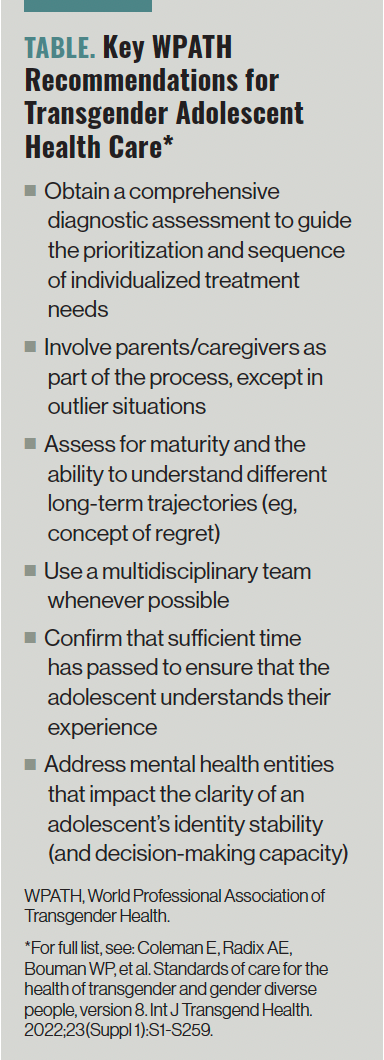Article
Gender-Affirming Care for Adolescents: Separating Political Polarization From Medicine
Author(s):
The politicization of gender-affirming care creates a harmful and dangerous reality for transgender youth.
New Africa/AdobeStock

SPECIAL POPULATIONS
COMMENTARY
In the past decade, gender and gender-diverse experiences have quickly become ubiquitous, central components of care within different child/adolescent psychiatry practice settings, and we—child and adolescent psychiatrists—find ourselves playing catch-up to learn best practices. We do so amid a period of egregious political intrusion into medical decisions that should be based on scientific consensus guidelines, not ideologically driven opinions.
In our current polarized environment, 2 competing narratives dominate the airwaves. On one hand, calls to “ban the care”1 seem to deny the importance and benefit of gender-affirming care for the many transgender youth whose lives remain in physical and psychological limbo while waiting to resolve the mind-body disconnect that characterizes their lived experience. On the other hand, calls to facilitate access to gender-affirming medical care for all young people who declare they need it2 seem to deny the reality that identity stability, and its impact on decision-making capacity, varies among adolescents. Neither narrative seems like a balanced approach that is designed to deliver appropriate care to those who need it while maintaining caution for those who likely do not. Put in statistical terms, efforts that exist to exclusively eliminate type 1 errors (eg, banning care for all youth) or type 2 errors (eg, assuming all care-seeking youth are appropriate for it), are gross oversimplifications that distract from the complexity of solutions intended to minimize both error types simultaneously.
This is why clinical guidelines—written by experts, not legislators—exist. Guidelines integrate consensus expert opinion with a translation of the available evidence into clinical practice recommendations. In essence, guidelines provide a framework on how to ethically deliver the care, not ban it completely nor provide unfettered access for a wide array of youth with differing needs.
Table. Key WPATH Recommendations for Transgender Adolescent Health Care*

In September 2022, the World Professional Association of Transgender Health (WPATH), the first professional association to generate clinical transgender health guidelines, published its eighth version of the Standard of Care (SOC8); the first was published in 1979.3 The previous guidelines, SOC7,4 were published a decade ago. In that time, clinical needs have exponentially risen and the complexity of presentations has increased. Over the last 5 years, 119 multidisciplinary transgender health experts from 18 countries developed the most comprehensive set of clinical guidelines on transgender health to date. Employing a Delphi consensus process, any recommendation in any chapter had to achieve at least 75% agreement among all experts to be included; this process, in itself, contributed to the evolving evidence base. Chapter 6, on adolescents, includes 12 recommendations that address the key relevant clinical issues; 6 of the most salient can be found in the Table. The guidelines aim to protect the integrity of the decision-making process for adolescents and their families by addressing co-occurring mental health issues, ensuring sufficient maturity, and involving parents and caregivers in the process.
For those debating the issues, the following main questions seem central to differing arguments:
1 Are there relevant trends regarding those who seek care?
2 Can (or should) adolescents make irreversible treatment decisions?
3 What is the evidence for the treatments? and
4 Which disciplines should be involved in determining appropriateness for the treatments?
Are there relevant trends regarding those who seek care?
Societal shifts in the conceptualization of gender from a dichotomous to a dimensional construct appear to have coincided with more young individuals asserting a nonbinary identity in clinical practice.5 Also, there has been an increase in adolescents who did not have gender-diverse expressions in childhood presenting for care; many of them have complex mental health conditions.6,7 Most interestingly, there has been an inversion in the assigned-sex ratio reported by clinics, with designated-females-at-birth presenting in gender clinics at substantially higher rates than designated-males-at-birth.8
Combined, these trends are often used to suggest that social contagion is unduly influencing adolescents’ desires to start hormones; thus, some conclude that gender-affirming medical treatment should always be deferred until adulthood. On the other hand, reflexive denial of the relevance or existence of these trends risks obstructing scientific advancement regarding interventions for youth who might have differing long-term needs.
Moreover, the question must be asked: In what other field of medicine do evolving clinical trends justify calls for an all-or-nothing approach to treatment access?
Should adolescents be allowed to make irreversible treatment decisions?
The long and short of it: some yes and some no. Adolescence is characterized by the progression of developmental processes across different domains (eg, cognitive, physical, emotional) that are rapidly and simultaneously maturing. Adolescents, in simple characterizations, are often reduced to risk-taking, socially influenced, emotionally driven decision makers. However, both the significance of the decision and the context in which it is made are important factors to consider. In some contexts, a heightened reward drive certainly outweighs inhibitory control, such as trying that first beer with friends at a party. For other decisions, planning and reasoning take place over a significant period of time, such as saving babysitting money over several years to help pay for a first car.
Understanding the factors involved in a particular decision is complex and requires appreciation of the individual’s emotional state, the underlying motivations driving it, and the time invested in planning.9,10 Reductionistic tropes that suggest adolescents cannot fully understand themselves enough to make a high-stakes decision until they reach a certain age oversimplify the many factors that go into a well-thought-out, individualized decision-making process, even for minors.
Again, we must ask: In what other field of medicine do gross mischaracterizations of a developmental group justify calls for an all-or-nothing approach to treatment access?
What is the evidence for the treatments?
The debate around medical treatments is often centered around the quality of evidence. In short, the evidence demonstrating benefit for gender-affirming care in minors is growing.11-19 Arguments have asserted there are not enough longitudinal studies and that the quality of the evidence is insufficient due to a lack of randomized control studies. Others claim that there is sufficient evidence and that the science is settled. In truth, the evidence is where one might expect it for a field relatively early in its development: evolving.
For instance, a significant longitudinal study demonstrates improvement in psychological well-being after youth received puberty suppression, gender- affirming hormones, and ultimately surgery.13 In that Dutch study, the youth (N = 55) underwent a comprehensive diagnostic assessment process over a period of several months. After receiving these gender-affirming treatments over time, their quality of life and subjective happiness were comparable with those of same-age peers, including a reduction from 30% of those meeting clinical threshold on the YSR/ASR to only 7%. More recent longitudinal research demonstrating benefit was published in the New England Journal of Medicine.19 In a 2-year longitudinal follow-up study of 315 youth, gender-affirming hormone care improved psychosocial functioning through a mechanism described as appearance congruence, the degree to which youth experience alignment between their gender and physical appearance.
A common argument is that adolescents are too young to make permanent decisions that could lead to regret. Narratives of detransitioners have also become more commonplace in the public domain, and the research in this area is also evolving.20-23 As with other studies, methodological limitations exist within this line of research. Some of the research on this topic has become more nuanced, describing different types of shift profiles for varying reasons why adolescents may shift away from their original decision, which often involves a re-request for medical treatment at a later date.24
What do not exist are:
1 Studies demonstrating long-term psychological benefits in the absence of care (which would be unethical), and
2 Research results to demonstrate that regret and detransition are the most likely outcomes for minors who transition medically.
What do exist are:
1 Evolving research results on direct benefits of care,
2 Research demonstrating that adolescents who start hormones as minors with parental oversight have higher continuation rates than adults,25 and
3 Research demonstrating the negative psychosocial consequences of early or delayed puberty in cisgender youth, suggesting the importance of timing for developing correct pubertal changes during adolescence.26,27
In my opinion, overly focusing on the quality of evidence distracts from the bigger picture. Claims of insufficient evidence negate the fact that transgender adolescents exist, and experiencing the correct physical changes of puberty during adolescence is important for their psychological well-being. Claims that the evidence is settled for all youth seeking care, without acknowledging evolving trends and assessment-informed evidence, negate the importance of an appropriately cautious approach.
So we must ask: In what other field of medicine, when the existing evidence points to both benefit and caution, are there justifications for all-or-nothing approaches to treatment access?
Which disciplines should be involved in determining appropriateness for those treatments?
The history of mental health involvement in transgender health is rife with conflict. In order to access gender-affirming medical care, transgender individuals have had to prove their identities in ways that may disrespect their humanity. The power differential between provider and patient, what has become known as “gatekeeping,” has led to a decades-long mistrust of the mental health community. Similarly, because of the historical conceptualization of transgender identities as a form of mental illness, many individuals feel that care should be removed from mental health providers’ offices; they fear that conversion therapy tactics will be used to promote a cisgender experience as the preferred outcome.28
In the midst of a national emergency in child and adolescent mental health,29 long waitlists for pediatric mental health providers can often result in care falling to the pediatrician. (This is the desired outcome for those who want to eliminate gatekeeping.)
After the call for an independent review of its only pediatric gender service (centralized in London at Tavistock),30 the United Kingdom’s National Health System decided to close the service with the intention of creating regional centers designed to increase mental health access. Therefore, it should come as no surprise that pediatric gender clinics across the world have significant variation in the way care is delivered, how waitlists are managed, and the degree to which mental health resources are integrated.
So who is best poised to conduct an assessment as recommended by the SOC8 guidelines? As a child and adolescent psychiatrist, I am biased to believe that mental health providers have the most appropriate training. The factors that most often impact decision-making and identity stability are psychiatric and psychological in nature. Additionally, the most commonly cited ramifications of the absence or delay of treatment are depression, anxiety, suicidal ideations, and poor psychological well-being.7 Therefore, calls to remove decision-making capacity assessments from mental health professionals seem just as misguided as the calls to eliminate the care completely.
In what other areas of medicine does this all-or-nothing discussion happen?
Concluding Thoughts
No matter where one stands on the ethics of minors making irreversible decisions for their bodies, the politicization of the matter itself creates a harmful and dangerous reality for transgender youth. That legislators are attempting to regulate the delivery of highly complex care is tragic in and of itself. In response, proponents promote and embrace low-quality evidence31 to justify immediate gender-affirming treatments for adolescents with severe mental health conditions. In this polarized world, it feels like political whiplash has led to the outright dismissal of clinical guidelines, thereby erasing the balanced, middle viewpoints on a complex subject.
We need to return to deliberations on how to do the care in place of deliberations on whether to do the care. This is what happens in the rest of medicine, in which there is no room for double standards. Transgender youth deserve no less; their experiences are real, there are treatments to help them achieve the same adolescent developmental milestones as their cisgender peers, and there are consensus- and evidence-informed clinical guidelines to help distinguish those who would benefit from treatment versus those who would not.
Ultimately, we should all advocate to keep these decisions where they belong: in the doctor’s office, among the patients, their caregivers, and their health care professionals.
Dr Leibowitz is a child & adolescent psychiatrist, an associate clinical professor at The Ohio State University College of Medicine, and medical director of the Behavioral Health, THRIVE Program (Gender and Sex Development Program) at Nationwide Children’s Hospital. He is the co-lead author for Standards of Care for the Health of Transgender and Gender Diverse People, Version 8 (Chapter 6, Adolescents).
References
1. Barbee H, Deal C, Gonzales G. Anti-transgender legislation – a public health concern for transgender youth. JAMA Pediatr. 2022;176(2):125-126.
2. Ashley F. Interrogating gender-exploratory therapy. Perspect Psychol Sci. 2023;18(2):472-481.
3. Coleman E, Radix AE, Bouman WP, et al. Standards of care for the health of transgender and gender diverse people, version 8. Int J Transgend Health. 2022;23(Suppl 1):S1-S259.
4. Coleman E, Bockting W, Botzer M, et al. Standards of care for the health of transsexual, transgender, and gender-nonconforming people, version 7. Int Journal Transgenderism. 2012;13(4):165-232.
5. Twist J, de Graaf NM. Gender diversity and non-binary presentations in young people attending the United Kingdom’s national Gender Identity Development Service. Clin Child Psychol Psychiatry. 2019;24(2):277-290.
6. McCallion S, Smith S, Kyle H, et al. An appraisal of current service delivery and future models of care for young people with gender dysphoria. Eur J Pediatr. 2021;180(9):2969-2976.
7. Sorbara JC, Chiniara LN, Thompson S, Palmert MR. Mental health and timing of gender-affirming care. Pediatrics. 2020;146(4):e20193600.
8. Arnoldussen M, Steensma TD, Popma A, et al. Re-evaluation of the Dutch approach: are recently referred transgender youth different compared to earlier referrals? Eur Child Adolesc Psychiatry. 2020;29(6):803-811.
9. Blakemore S-J, Robbins TW. Decision-making in the adolescent brain. Nat Neurosci. 2012;15(9):1184-1191.
10. Vrouenraets LJJJ, de Vries ALC, de Vries MC, et al. Assessing medical decision-making competence in transgender youth. Pediatrics. 2021;148(6):e2020049643.
11. Arnoldussen M, van der Miesen AIR, Elzinga WS, et al. Self-perception of transgender adolescents after gender-affirming treatment: a follow-up study into young adulthood. LGBT Health. 2022;9(4):238-246.
12. Costa R, Dunsford M, Skagerberg E, et al. Psychological support, puberty suppression, and psychosocial functioning in adolescents with gender dysphoria. J Sex Med. 2015;12(11):2206-2214.
13. de Vries ALC, McGuire JK, Steensma TD, et al. Young adult psychological outcome after puberty suppression and gender reassignment. Pediatrics. 2014;134(4):696-704.
14. Grannis C, Leibowitz SF, Gahn S, et al. Testosterone treatment, internalizing symptoms, and body image dissatisfaction in transgender boys. Psychoneuroendocrinology. 2021;132:105358.
15. Kuper LE, Stewart S, Preston S, et al. Body dissatisfaction and mental health outcomes of youth on gender-affirming hormone therapy. Pediatrics. 2020;145(4):e20193006.
16. Morningstar M, Thomas P, Anderson AM, et al. Exogenous testosterone administration is associated with differential neural response to unfamiliar peer’s and own caregiver’s voice in transgender adolescents. Dev Cogn Neurosci. 2023;59:101194.
17. Nieder TO, Mayer TK, Hinz S, et al. Individual treatment progress predicts satisfaction with transition-related care for youth with gender dysphoria: a prospective clinical cohort study. J Sex Med. 2021;18(3):632-645.
18. Olsavsky AL, Grannis C, Bricker J, et al. Associations among gender-affirming hormonal interventions, social support, and transgender adolescents’ mental health. J Adolescent Health. Published online April 5, 2023.
19. Chen D, Berona J, Chan YM, et al. Psychosocial functioning in transgender youth after 2 years of hormones. N Engl J Med. 2023;388(3):240-250.
20. Littman L. Individuals treated for gender dysphoria with medical and/or surgical transition who subsequently detransitioned: a survey of 100 detransitioners. Arch Sex Behav. 2021;50(8):3353-3369.
21. MacKinnon KR, Kia H, Salway T, et al. Health care experiences of patients discontinuing or reversing prior gender-affirming treatments. JAMA Netw Open. 2022;5(7):e2224717.
22. Pullen Sansfaçon A, Gelly MA, Gravel R, et al. A nuanced look into youth journeys of gender transition and detransition. Infant and Child Development. 2023;32(2):e2402.
23. Vandenbussche E. Detransition-related needs and support: a cross-sectional online survey. J Homosex. 2021;69(9):1602-1620.
24. Cohen A, Gomez-Lobo V, Willing L, et al. Shifts in gender-related medical requests by transgender and gender-diverse adolescents. J Adolesc Health. 2023;72(3):428-436.
25. Roberts CM, Klein DA, Adirim TA, et al. Continuation of gender-affirming hormones among transgender adolescents and adults. J Clin Endocrinol Metab. 2022;107(9):e3937-e3943.
26. DeRose LM, Shiyko MP, Foster H, Brooks-Gunn J. Associations between menarcheal timing and behavioral developmental trajectories for girls from age 6 to age 15. J Youth Adolesc. 2011;40(10):1329-1342.
27. Zhu J, Chan YM. Adult consequences of self-limited delayed puberty. Pediatrics. 2017;139(6):e20163177.
28. Ashley F. Gatekeeping hormone replacement therapy for transgender patients is dehumanising. J Med Ethics. 2019;45(7):480-482.
29. AAP-AACAP-CHA Declaration of a National Emergency in Child and Adolescent Mental Health. American Academy of Pediatrics. Updated October 19, 2021. Accessed March 27, 2023. https://www.aap.org/en/advocacy/child-and-adolescent-healthy-mental-development/aap-aacap-cha-declaration-of-a-national-emergency-in-child-and-adolescent-mental-health/
30. Independent review of gender identity services for children and young people; interim report. The Cass Review. Accessed March 27, 2023. https://cass.independent-review.uk/publications/interim-report/
31. Turban JL, King D, Carswell JM, Keuroghlian AS. Pubertal suppression for transgender youth and risk of suicidal ideation. Pediatrics. 2020;145(2):e20191725.






